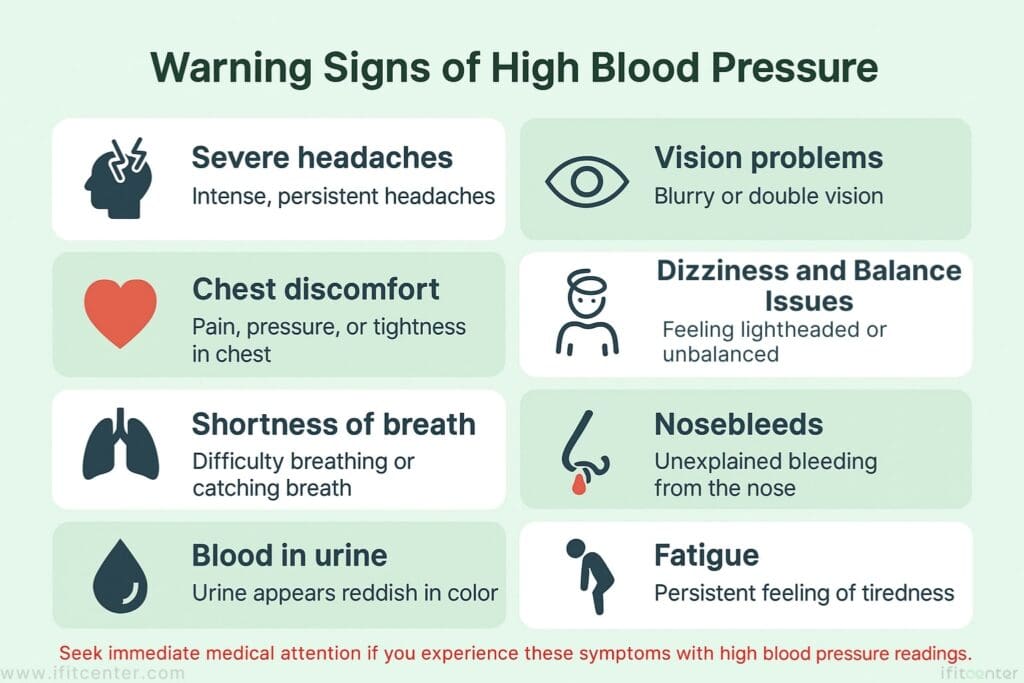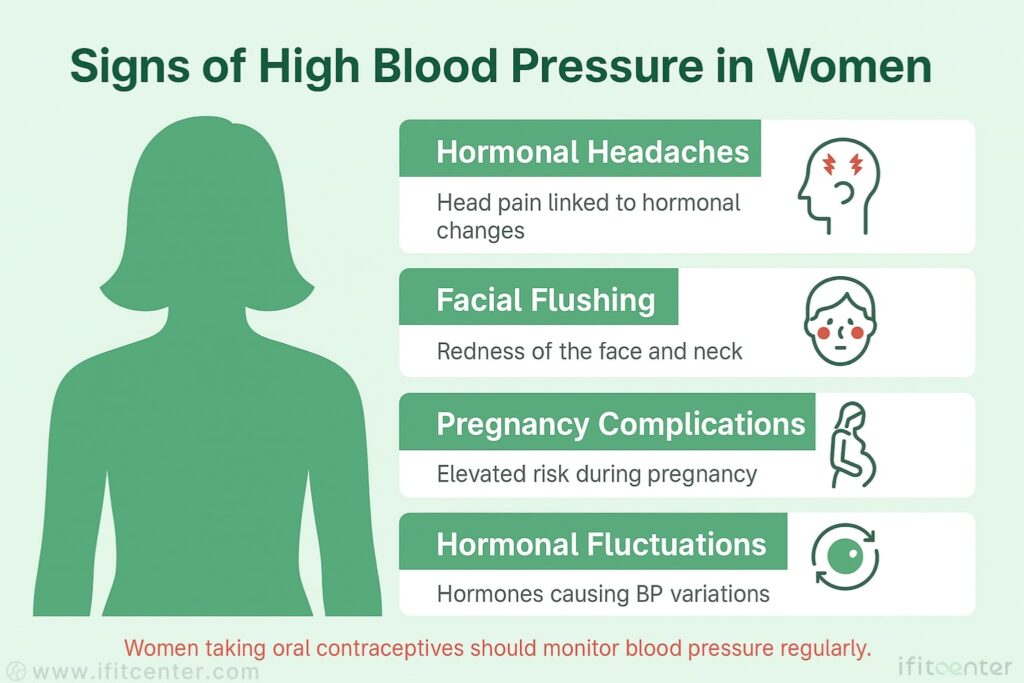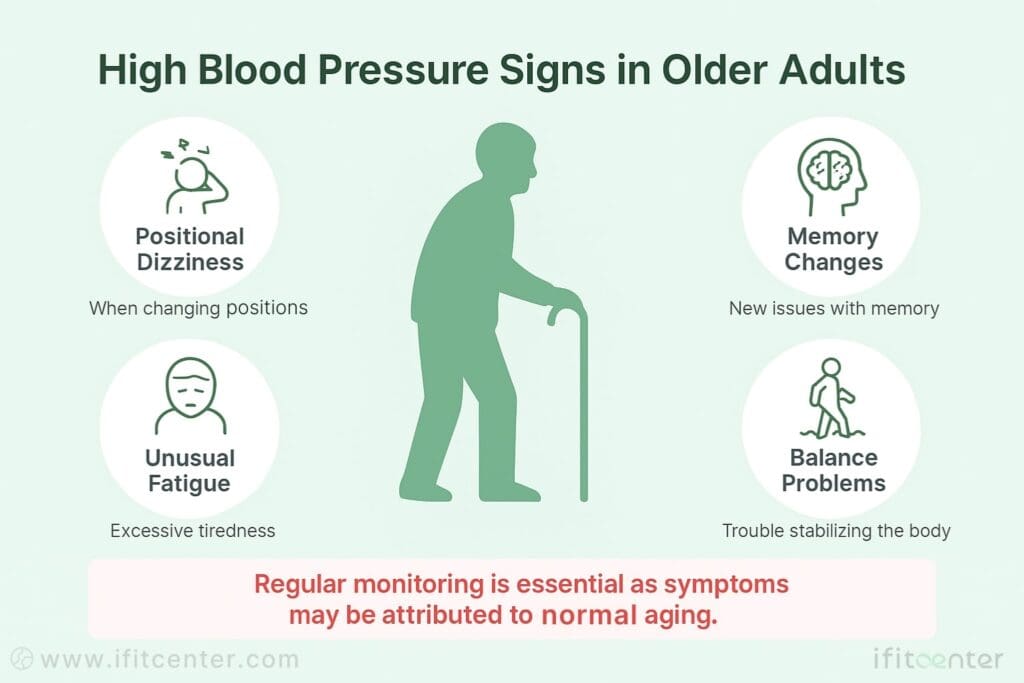One of the most dangerous myths about hypertension is that you’ll always feel it coming on—that headaches, dizziness, or nosebleeds will reliably warn you when your blood pressure is climbing. The sobering truth? Most people with high blood pressure experience absolutely no symptoms at all, even when their readings reach levels that could trigger a stroke or heart attack. This misconception leads millions to remain complacent until serious damage has already occurred.
Another common misbelief is that the signs of high blood pressure are obvious and impossible to miss. In reality, when symptoms do appear, they’re often subtle and easily attributed to other causes—stress, age, or minor illnesses. This misattribution means critical warning signs go unrecognized until a crisis develops. According to studies reviewed in the Journal of Hypertension, even healthcare providers sometimes fail to recognize the more nuanced presentations of hypertensive conditions.
At IFitCenter, we’re committed to dispelling these dangerous myths by providing accurate, evidence-based information about hypertension and its potential warning signs. This comprehensive guide examines the possible symptoms that might indicate high blood pressure, while emphasizing that the absence of symptoms doesn’t mean absence of risk.
Understanding both the presence and absence of warning signals could be crucial for your cardiovascular health—let’s explore what your body might (or might not) be telling you about your blood pressure.
Signs of High Blood Pressure You Shouldn’t Ignore

While high blood pressure often develops without any noticeable symptoms, there are certain warning signs that may appear, particularly when blood pressure reaches dangerously high levels. Being aware of these potential indicators could help you identify a problem before it leads to serious complications.
Severe Headaches as a Sign of High Blood Pressure
Headaches associated with high blood pressure typically occur when blood pressure reaches extremely high levels, particularly during a hypertensive crisis (180/120 mmHg or higher). These headaches often feel different from ordinary ones – they may be severe, occur predominantly in the morning, and localize at the back of the head.
Unlike tension headaches or migraines, high blood pressure headaches typically don’t respond well to regular pain medications. If you experience a sudden, severe headache accompanied by confusion, blurred vision, or difficulty speaking, this could indicate a hypertensive emergency requiring immediate medical attention.
On the IFitCenter blog, we have prepared a free information database about various diseases, including high blood pressure, for you, our dear readers. By reviewing these resources, you will gain valuable information for controlling and preventing these conditions. To access the first part of the information, you can use the links below:
- What Is Normal Blood Pressure?
- Blood Pressure Chart
- Cause of High Blood Pressure
- The Correct Way to Measure Blood Pressure at Home
- How to Lower Blood Pressure Naturally?
Vision Problems and High Blood Pressure
High blood pressure can damage the delicate blood vessels in your eyes, potentially causing vision changes. These may include:
- Blurred vision or temporary vision loss
- Seeing spots or floaters
- Double vision
- Difficulty focusing
These visual disturbances occur because hypertension can cause swelling in the optic nerve and damage to the small blood vessels in the retina. Persistent high blood pressure may eventually lead to hypertensive retinopathy, a condition that can permanently affect your vision if left untreated.
Chest Discomfort and High Blood Pressure
Chest pain or discomfort can sometimes indicate elevated blood pressure, particularly when it reaches crisis levels. This discomfort may feel like pressure, squeezing, or fullness in the center or left side of the chest. It might also be accompanied by pain that radiates to the shoulder, arm, back, neck, or jaw.
Any chest pain, especially when accompanied by shortness of breath, cold sweat, or nausea, should be treated as a medical emergency, as it could indicate a heart attack triggered by high blood pressure or other cardiovascular issues.
Dizziness and Balance Issues
Dizziness related to high blood pressure typically feels like lightheadedness or a sensation that you might faint. This occurs because extremely high blood pressure can affect blood flow to the brain. However, it’s important to note that dizziness can also occur with low blood pressure or as a side effect of blood pressure medications.
When dizziness is accompanied by severe headache, confusion, or difficulty speaking, it may indicate a hypertensive emergency requiring immediate medical attention.
Shortness of Breath as a Sign of High BP
Difficulty breathing or shortness of breath can be associated with high blood pressure, particularly when hypertension begins to affect heart function. When blood pressure remains elevated for extended periods, it can cause the heart to work harder, potentially leading to heart failure where the heart cannot pump blood efficiently.
Shortness of breath may be most noticeable during physical activity or when lying flat. If you find yourself suddenly waking up gasping for air or needing to prop yourself up with pillows to breathe comfortably while sleeping, these could be warning signs that warrant medical attention.
Nosebleeds and High Blood Pressure
While most nosebleeds aren’t caused by high blood pressure, they can occur during hypertensive crises when blood pressure reaches extremely high levels. This happens because the increased pressure can cause tiny blood vessels in the nose to burst.
A nosebleed might be related to high blood pressure if it:
- Occurs spontaneously (not from injury or nose picking)
- Is difficult to stop
- Happens alongside other symptoms like severe headache or dizziness
Most nosebleeds are caused by dry air, allergies, or minor irritations rather than hypertension. However, frequent or severe nosebleeds should be evaluated by a healthcare provider.
Blood in Urine as a Warning Sign
Blood in the urine (hematuria) can occur when long-term high blood pressure damages the kidneys’ delicate filtering structures. This symptom typically appears in advanced stages of hypertension-related kidney damage.
The presence of blood may range from visible red-colored urine to microscopic amounts only detectable through laboratory testing. If you notice blood in your urine, seek immediate medical attention, as this can indicate significant kidney damage that requires prompt treatment.
Fatigue and Cognitive Changes
Persistent high blood pressure can lead to fatigue and subtle changes in cognitive function. These symptoms occur because hypertension affects blood flow to the brain and other organs, potentially reducing oxygen delivery.
Signs to watch for include:
- Unusual tiredness or exhaustion
- Difficulty concentrating
- Memory problems
- Confusion or mental fogginess
- Changes in mood or irritability
These cognitive changes typically develop gradually and might be subtle at first. However, they can signal that high blood pressure is affecting brain function and should not be ignored.
It’s important to remember that while these signs and symptoms can indicate high blood pressure, many people with hypertension experience no symptoms at all. Regular blood pressure checks remain the most reliable way to detect hypertension before it causes damage to your organs.
When Signs of High Blood Pressure Indicate an Emergency
A hypertensive emergency occurs when blood pressure rises to dangerously high levels (180/120 mmHg or higher). This condition requires immediate medical attention as it can cause rapid damage to organs and blood vessels, potentially leading to life-threatening complications.
Watch for these warning signs that may indicate a hypertensive emergency:
- Severe headache accompanied by confusion or blurred vision
- Chest pain or pressure that may radiate to the arms, back, or jaw
- Significant shortness of breath with anxiety
- Seizures
- Sudden weakness or numbness in the face, arm, or leg (especially on one side)
- Difficulty speaking or understanding speech
- Severe nosebleed that won’t stop
If you experience any of these symptoms, call emergency services (911) immediately. Do not attempt to drive yourself to the hospital, and do not wait to see if symptoms improve on their own. Every minute counts during a hypertensive emergency.
“In hypertensive emergencies, when blood pressure exceeds 180/120 mmHg, immediate organ damage can occur. What’s critical to understand is that the presentation varies significantly between patients. Headaches associated with these dangerous levels typically localize to the occipital region, occur predominantly in the morning, and prove resistant to conventional analgesics. These are not ordinary headaches, and when accompanied by neurological symptoms like confusion or speech difficulties, they signal a medical emergency requiring immediate intervention. Unfortunately, these nuanced presentations are frequently attributed to stress or minor illness, delaying potentially life-saving treatment.”
Dr. Babak Jamalian, Family Physician
Special Considerations for Different Groups
Signs of High Blood Pressure in Women

Women may experience some high blood pressure symptoms differently than men. Hormonal fluctuations throughout a woman’s life—during menstruation, pregnancy, and menopause—can influence how hypertension presents and progresses.
Women with high blood pressure might experience:
- Facial flushing
- Hormonal headaches that worsen with high blood pressure
- Pregnancy complications if hypertension is present
- Changes in symptoms during different hormonal phases
Women taking oral contraceptives should be particularly vigilant about monitoring their blood pressure, as some birth control methods can increase blood pressure in susceptible individuals.
Signs of High Blood Pressure During Pregnancy
Hypertension during pregnancy requires special attention as it can develop into preeclampsia, a potentially dangerous condition for both mother and baby. Preeclampsia typically develops after the 20th week of pregnancy.
Warning signs to watch for include:
- Severe headaches that don’t respond to over-the-counter pain relievers
- Changes in vision, including temporary blindness, blurred vision, or seeing spots
- Upper abdominal pain, usually under the ribs on the right side
- Sudden swelling (edema) in the face, hands, or feet
- Sudden weight gain (more than 2 pounds in a week)
- Nausea and vomiting (in the second half of pregnancy)
Contact your healthcare provider immediately if you experience any of these symptoms during pregnancy. Regular prenatal visits are crucial for monitoring blood pressure and detecting potential problems early.
Signs in Older Adults

Older adults may experience hypertension symptoms differently due to age-related changes in the cardiovascular system. Additionally, they often have other health conditions that can mask or complicate the recognition of high blood pressure signs.
In older adults, be aware of:
- Dizziness when changing positions (orthostatic hypertension)
- Memory changes or confusion that might be attributed to “normal aging”
- Fatigue that seems disproportionate to activity levels
- Balance problems that may increase fall risk
Regular blood pressure monitoring is particularly important for older adults, who may have “white coat hypertension” (elevated readings only in clinical settings) or masked hypertension (normal readings in clinical settings but elevated at home).
Home Blood Pressure Monitoring: Catching Warning Signs Early
Home blood pressure monitoring is one of the most effective ways to detect hypertension early and track how well treatment strategies are working. Regular monitoring can help identify patterns and changes before serious symptoms develop.
For accurate home readings:
- Use a validated upper-arm monitor (wrist monitors are less reliable)
- Sit with your back supported and feet flat on the floor
- Rest for 5 minutes before measuring
- Position your arm at heart level, supported on a flat surface
- Don’t talk during the measurement
- Take 2-3 readings, 1 minute apart, and record the average
- Measure at the same times each day (morning and evening)
Contact your healthcare provider if:
- Your readings are consistently above 130/80 mmHg
- You notice a sudden increase in your typical readings
- You experience symptoms along with elevated readings
- Your readings exceed 180/120 mmHg (seek immediate emergency care)
“Home blood pressure monitoring provides crucial data that occasional office measurements cannot capture. For optimal accuracy, use validated upper-arm monitors, rest for 5 minutes before measuring, and take readings at consistent times daily. Current guidelines recommend medical consultation when home readings are consistently above 130/80 mmHg. What many patients don’t realize is that morning measurements often reveal nocturnal hypertension patterns strongly associated with increased cardiovascular risk. This systematic approach to monitoring enables us to identify concerning patterns before they lead to complications and allows for personalized treatment adjustments based on your unique blood pressure profile.”
Dr. Babak Jamalian, Family Physician
Lifestyle Factors That May Worsen High Blood Pressure Symptoms
Certain lifestyle factors can exacerbate high blood pressure and make symptoms more likely to appear. Being aware of these factors can help you reduce your risk of experiencing hypertension-related symptoms.
Control Blood Pressure Naturally at IFitCenter
Experiencing fatigue, headaches, or sleep issues? These signs may be linked to elevated blood pressure. At IFitCenter, Dr. Babak Jamalian leads medically supervised programs that help you manage hypertension at the root—through sustainable weight loss and lifestyle transformation:
✔ Evidence-based weight-loss plans that reduce pressure on your heart
✔ Personalized nutrition designed to support blood vessel health
✔ Regular monitoring to adjust your strategy as your body changes
Let’s build a long-term plan tailored to your body and lifestyle.
Dietary Influences
What you eat can significantly impact your blood pressure. Key dietary factors include:
- Sodium intake: High salt consumption can raise blood pressure in salt-sensitive individuals
- Processed foods: Often high in both sodium and unhealthy fats
- Alcohol: More than 1-2 drinks per day can raise blood pressure
- Caffeine: May cause temporary spikes in blood pressure
Stress Management
Chronic stress activates your sympathetic nervous system, which can increase blood pressure. During stressful periods, you might notice:
- More frequent headaches
- Sleep disturbances
- Increased heart rate
- Higher blood pressure readings
Sleep Quality
Poor sleep or sleep disorders like sleep apnea can contribute to hypertension. Less than 6 hours of sleep per night has been linked to increased blood pressure and more pronounced symptoms.
Physical Activity Levels
Regular physical activity helps regulate blood pressure, while a sedentary lifestyle can worsen hypertension. Even moderate exercise can help reduce the frequency and severity of high blood pressure symptoms.
Looking for personalized guidance on managing these lifestyle factors? Consider scheduling a consultation to develop a customized plan for your specific needs.
Conclusion: Recognizing the Signs, Taking Action
While high blood pressure often remains symptomless, being aware of potential warning signs can help you identify dangerous situations that require attention. The most important signs to watch for include severe headaches, vision changes, chest discomfort, dizziness, shortness of breath, and unexplained fatigue.
Remember that the absence of symptoms doesn’t mean absence of risk. Many people with hypertension never experience noticeable symptoms, even as damage occurs to their cardiovascular system.
The most reliable way to detect high blood pressure is through regular monitoring, either at home or during healthcare visits. As Dr. Babak notes, “Regular blood pressure checks are your best defense against the silent damage of hypertension. Don’t wait for symptoms to appear before taking action.”
If you experience any of the warning signs discussed in this article, especially if they occur suddenly or severely, don’t hesitate to seek medical attention. Early intervention can prevent serious complications and protect your long-term health.
Take charge of your cardiovascular health today by establishing a regular monitoring routine and staying alert to how your body feels. Your vigilance could make all the difference in preventing the serious consequences of uncontrolled hypertension.
To access other content on the IFitCenter’s blog, you can use the following links:
References
- Kidwai, S., Haris, M., Bilal, A., Saleem, S., Imran, H., Anwar, A., & Hashmi, A. A. (2024). High Blood Pressure-Associated Symptoms: Insights From a Population-Based Study in Pakistan. Cureus, 16(7), e65446. DOI: 10.7759/cureus.65446
- Ramdani, S., & Haddiya, I. (2024). Updates in the management of hypertension. Annals of Medicine and Surgery (London), 86(6), 3514-3521. DOI: 10.1097/MS9.0000000000002052
- Siddiqi, T. J., Usman, M. S., Rashid, A. M., Javaid, S. S., Ahmed, A., Clark III, D., Flack, J. M., Shimbo, D., Choi, E., Jones, D. W., & Hall, M. E. (2023). Clinical Outcomes in Hypertensive Emergency: A Systematic Review and Meta-Analysis. Journal of the American Heart Association, 12(14), e029355. DOI: 10.1161/JAHA.122.079355
- Kowalski, S., Goniewicz, K., Moskal, A., Al-Wathinani, A. M., & Goniewicz, M. (2023). Symptoms in Hypertensive Patients Presented to the Emergency Medical Service: A Comprehensive Retrospective Analysis in Clinical Settings. Journal of Clinical Medicine, 12(17), 5495. DOI: 10.3390/jcm12175495



